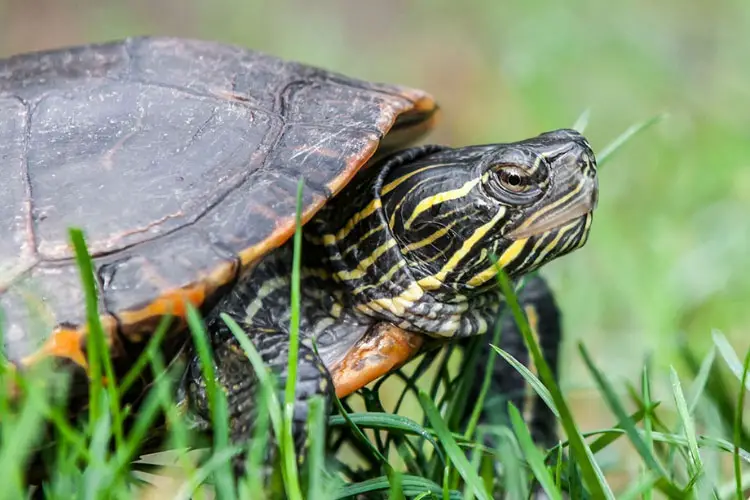Painted Turtle Care: How to deal with a Painted Turtle as a pet?
The painted turtle is one of the most prevalent species of wild turtle found in the United States. Their behaviors are comparable with cooters and sliders. It has dark green or black skin with red or yellow stripes and a red or yellow plastron.
However, taking care of painted turtles involves significant responsibility. It is necessary to pay close attention to its nutrition, the temperature of the surroundings, and the water to provide painted Turtles with the highest level of care possible. For further information about painted turtle care, read the following article.
Basic Info about Painted Turtle
Contents
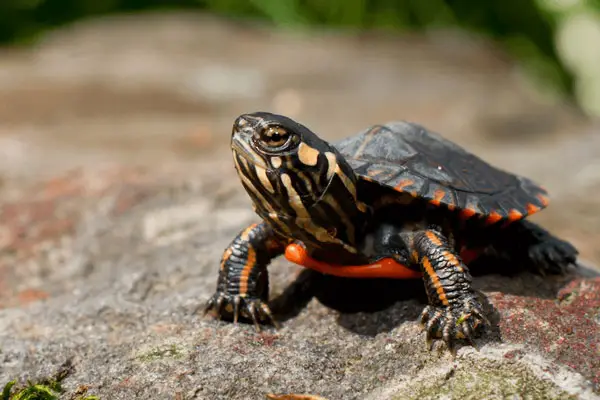
| Scientific Name/ Common Name | Chrysemys picta |
| Adult Size | 5-6 inch long |
| Max Size | 50-10 inches long |
| Lifespan | 35-40 year |
| Diet | Crustaceans, fish, aquatic insects, carrion, and other small animals. |
| Range | Quebec, Northwest Alabama, Southern Ontario, Tennessee, Kentucky, and US Midwest states. |
| Behavior | Diurnal (active in day time) |
| Clutch Size | About 0.55 by 1.3 inches and contains 4 to 10 whitish eggs. |
| Legal to Keep in USA | Yes |
| Extinction Status | No, extinct |
Are Painted Turtles Easy to Take Care of?
Yes, painted turtles are easy to care for with suitable habitats and diets. However, the dietary needs of painted turtles demand particular care and attention. Without the proper diet or nutritional balance, turtles can become ill and develop a variety of ailments, including parasites, shell infections, respiratory illnesses, abscesses, and deficiencies in vitamin A.
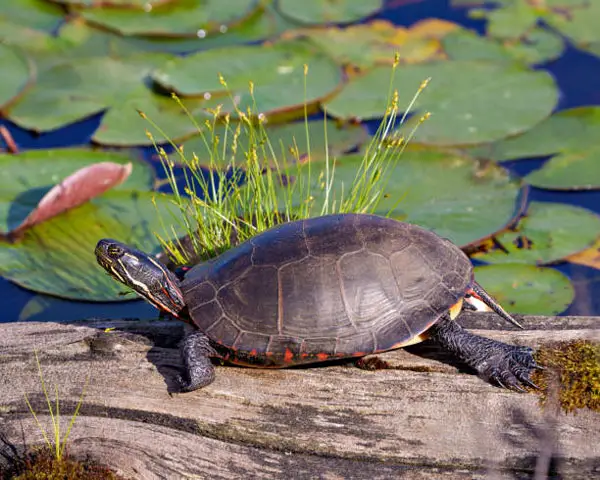
How to Take Care of a Painted Turtle?
Below there are some maintenance considerations for painted turtles as pets.
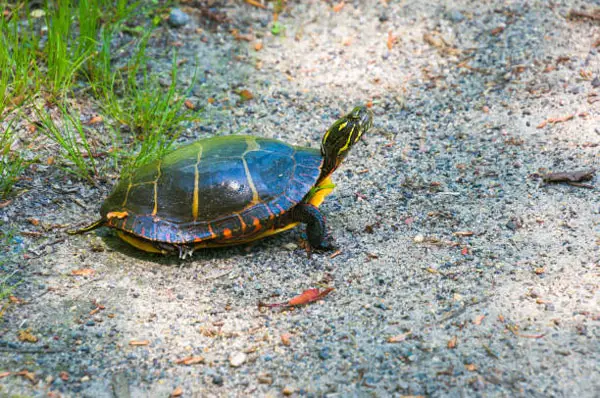
Baskin spots and shelter
Even though turtles have a natural protective shell, they still require a safe hiding spot. To accomplish this, you can use either artificial or natural plants to build an underwater hideout. Make sure your Turtle can’t get stuck in the hiding place you’ve made for it; otherwise, it could drown. Regular plant inspections and replacements are required.
If you’re keeping your Turtle outside, at least part of its enclosure should be in direct sunlight. Since these reptiles enjoy basking in the sunshine, they need a spot to haul themselves out of the water and dry off. Use a surface that won’t damage your Turtle’s shell, such as a flat rock, a piece of driftwood, or a corkboard. Put a UVB spotlight over your Turtle’s indoor enclosure so it can catch some sun.
Water
You’ll need 20 gallons of water for one painted turtle, and an additional 10 gallons for each extra turtle. Always aim for more; it’s the minimum needed.
The cage must be watertight since painted turtles are sea animals. The use of a stock Pond, tank, or aquarium is all that is required for this.
Moreover, these turtles thrive in water and do best in ponds with natural substrates like stones or sand. In addition, both indoor and outdoor ponds are far better environments for painted turtles than aquariums.
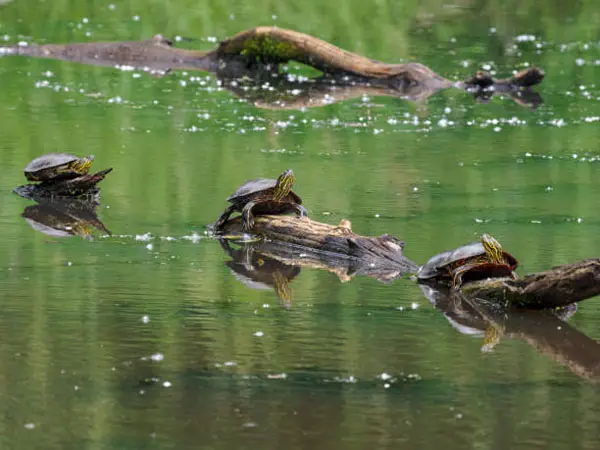
Create ramps and access points for your Turtle to enter and exit the pond from all sides. In addition, you should clean the water every day using a water vacuum and place the pond in a shady area to prevent the water from being too heated.
Heating
Unlike most other reptiles, painted turtles are ectothermic, which generates heat from the environment rather than internally. Putting up an under-tank heater is a sensible strategy to increase the overall heating capacity of the room.
Whatever water heater you end up going with, you’ll want to have digital thermometers on hand to keep the temperature from ever being dangerous. Electronic thermometers with alarms set for either a drop or an increase in temperature should be used to ensure everything stays at a safe temperature.
- Water temperature for Juveniles: 25-27 degrees C
- Water temperature for adults: 21-24 degrees C
- Baskin surface temperature: 35-40 degrees C
- Decor
Decorating its habitat is an excellent method if you want to keep your Turtle active in mind and body. Your pet will benefit from the exercise, mental stimulation, and gratification of its natural tendencies that come from these playthings and the fun it will have climbing and hiding in them.
You can provide your Turtle with enrichment in the form of substrate, wood, rocks, a cave, aquatic vegetation, and even (suitable) live fish. If your Turtle accidentally ingests grit or stones, you should be aware that this could have significant repercussions for its health. So, in place of smaller boulders, use river rocks that are one foot or larger if you like a stonier appearance. Underwater hiding areas should be roomy to avoid the Turtle becoming trapped.
Painted Turtle Care Sheet for Food
Painted turtles are omnivores, so they must consume plant and animal stuff to meet their nutritional requirements. Full grown painted turtles have specific food requirements.
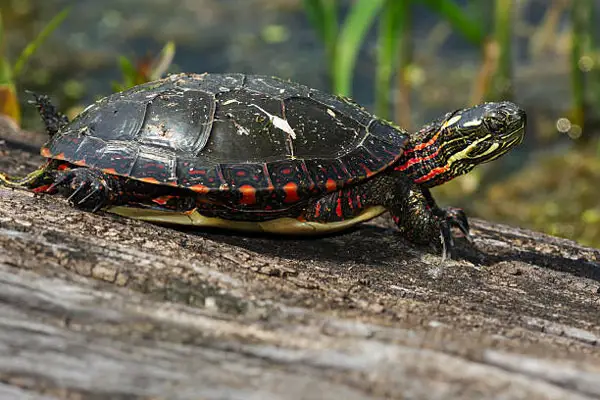
From 6 to 12 months:
- Should be 50% protein or 50% veggies in the diet
- Every other day: protein food or pellets
- Daily intake of vegetable
For 1 year:
- Should be 75% vegetables and 25 % of protein
- 2 or 3 times a week pellets or protein-rich food
- Daily intake of vegetable
Your Painted Turtle needs a portion of a protein that is equivalent to what it can take in five to ten minutes, a part of vegetables that is equivalent in length to its shell, and a portion of pellets around the same size as its head.
Here’s a quick rundown of some all-natural, high-quality options for feeding your painted Turtle the finest diet possible:
Vegetables
- Raw and grated carrot
- Raw and grated squash
- Raw grated sweet potato
- Red leaf lettuce
- Collard greens
- Kale
- Endive
- Romaine lettuce
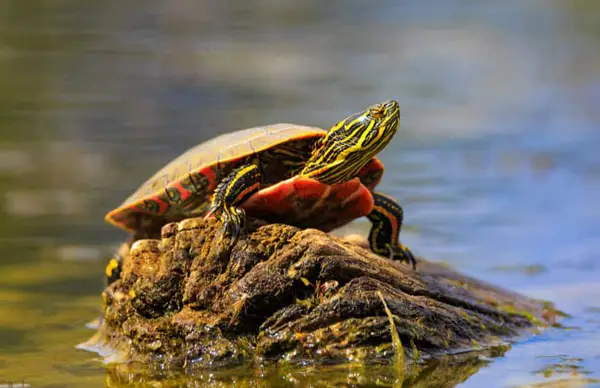
Protein
- Silkworms
- Snails
- Platies
- Earthworm
- Guppies
- Earthworms
- Dubia roaches
- Guppies
- Mosquito fish
- Frozen bloodworms
- Mollies
Supplements
Aside from protein and plant-based diets, your painted Turtle also regularly needs calcium and vitamin supplements. If you provide your Turtle with commercial turtle pellets and a calcium block for it to chew on, you can help it maintain a healthy shell and shell musculature.
Can You Keep a Painted Turtle as a Pet?
Yes, you can keep a painted turtle as pet. The calm demeanor of painted turtles makes them an ideal pet. But unlike most ordinary pets, they require continual attention and unique maintenance, making them more challenging to care for.
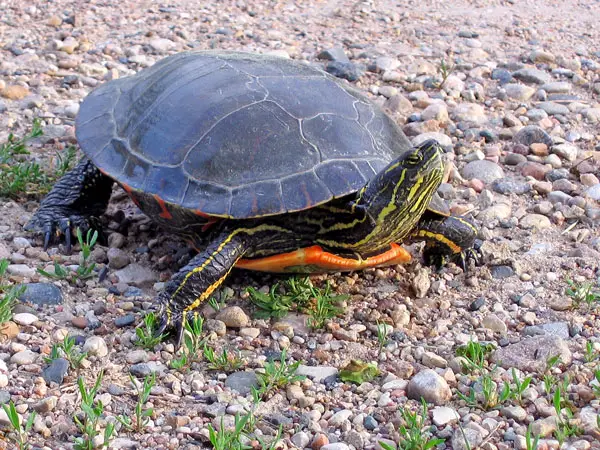
Despite their laid-back nature and slow speed, they can become anxious when lifted repeatedly. They can become defensive if picked up and may lash out with bites and scratches.
Simply from an observational standpoint, they are great pets since they are attractive animals to watch. However, the painted Turtle is not your best bet if you want a friendly, cuddly pet.
What does a painted turtle need in a tank?
A great quantity of water, a dock or another spot in the tank where the Turtle may sun itself and thoroughly dry itself off, an effective filter, and an underwater light are all necessary components for a perfect habitat for a painted turtle.
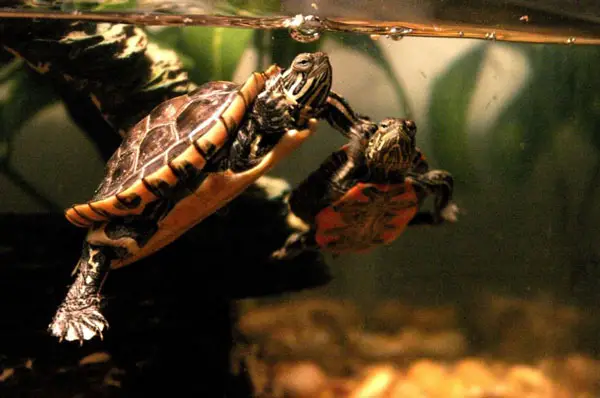
Housing for Painted Turtles
It is entirely up to you how you design the housing for your painted turtle. But there are some basic requirements that you should meet.
It is ideal to have water twice as deep as the width of the turtle’s shell. Also,the painted turtle needs a dry resting area where it can completely dry off and a pleasant resting light to help it maintain its body temperature.
Furthermore, painted turtles should also have access to a safe underwater hiding place, but you must design this location carefully to avoid trapping the turtle. Painted turtles can benefit from non-toxic live plants for eating and hiding.
However, painted turtles may or may not eat vegetation but will destroy them over time. To give your painted turtle’s tank a more natural appearance, line it with sand, gravel, or another substrate whose particles are too large for them to consume or too little to pass through their digestive system.
Final Words
Painted turtles earned their moniker from their brilliant coloring; they are stunning animals. However, they are tough to maintain and handle, their extraordinarily lengthy lifespans making them a great option to have a good company for many years. Especially people who seek a placid, peaceful pet that doesn’t need your continual attention to find this Turtle suitable to keep as a pet.
I’ve compiled the most helpful tips on painted turtle care in this article. Hope this article will make maintaining your painted Turtle a little hassle.


